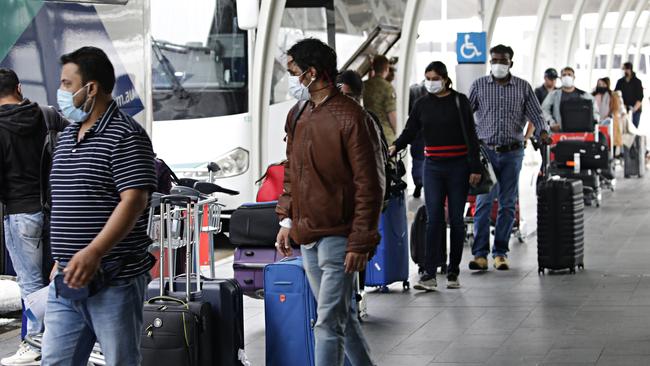Budget 2020: Welcome mat rolled out for the ‘best and brightest’
Scott Morrison will keep the migration cap at 160,000 places next year and boost recruitment of highly skilled foreigners.

Australia will have 72,000 fewer migrants than departures in the year ending June, pushing population growth to its lowest level in more than a century, as travel restrictions and weak demand for workers keeps people away.
But Treasury forecasts show the decline in net overseas migration, the first since 1946, will be short-lived, with 201,000 extra people expected in 2023-24.
The Morrison government intends to keep the migration cap at 160,000 places next year and boost visa incentives and recruitment of highly skilled foreigners to attract “the best and brightest migrants from around the world”.
The budget papers warn that “substantially slower population growth” will weigh heavily on the economic turnaround. “Australia’s population growth is expected to fall to 0.2 per cent in 2020-21 and 0.4 per cent in 2021-22, the slowest growth in over a century, due to net overseas migration which is expected to be negative over this period for the first time since 1946,” the papers say.
“Working-age population growth is expected to be lower over the medium term than was assumed in MYEFO.
“This reflects lower net overseas migration, as fewer people are able to enter Australia during the COVID-19 pandemic.
“Population growth is also affected by a lower fertility rate assumption, which has been updated to reflect recent trends.”
Treasury forecasts negative migration will push population growth to just 0.2 per cent this year, and 0.4 per cent in 2021-22.
Home Affairs Minister Peter Dutton said a “carefully managed migration program” would play a key role in Australia’s economic recovery, led by a tripling of the Global Talent independent visa program to 15,000 places and increasing the Business Innovation and Investment scheme to 13,500 places.
“The BIIP will also be streamlined and reformed to ensure that investments are targeted at Australian venture capitals and emerging small- and medium-size businesses to support the economic recovery,” Mr Dutton said.
“The family-stream planning level has been set at 77,300 places (up from 47,732), including 72,300 within the partner category. While overall the government has placed greater emphasis on the family stream, most of these are people already in Australia.
“Of the new permanent residents coming into the country, we still anticipate that approximately two-thirds will be in the skilled stream and one third from the family stream.”
The government has allocated 13,750 places under the humanitarian program and will offer visa application charge refunds, waivers and extensions to visa holders who have been unable to travel to Australia during COVID-19.
Mr Dutton said this would include waiving charges for working holidaymakers and visitors to boost tourism when borders reopen. Treasury forecasts that the increased number of places for partner visas and the prioritisation of onshore migrants would “reduce receipts by $320m over the forward estimates”.
The government will spend $123.1m boosting English-language services and income support for migrants, which will be partially offset by reduced GST payments to the states and territories of $55m over four years.
Treasury said internal border closures and strict coronavirus restrictions had placed significant pressure on net internal migration.
“The COVID-19 pandemic is projected to lower Australia’s potential output growth in the near term, by affecting all three supply-side drivers of growth: population, participation and productivity,” the budget papers said.
“The fiscal impact of COVID-19 will persist across the medium term. Lower population growth from lower net overseas migration during the COVID-19 pandemic will continue to weigh on the economy.
“Australia’s economy will be persistently smaller as a result of the COVID-19 pandemic, relative to previous forecasts. While growth is expected to recover strongly as restrictions are eased, this will come from a smaller base.”
Treasury also warned lower population growth from lower net overseas migration during the pandemic would “weigh on the economy into the medium term”.




To join the conversation, please log in. Don't have an account? Register
Join the conversation, you are commenting as Logout